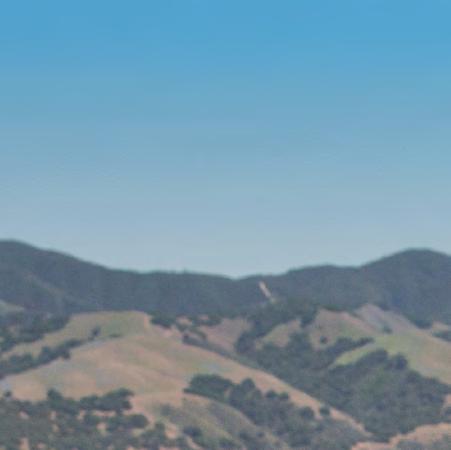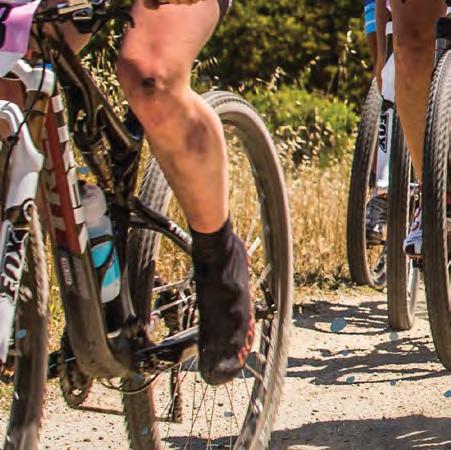BLACK GIRLS SURF


CROSSING STATE LINES
The Upper Klamath
Riding Against Racism

Summer Water Ways
Indigenous Fire Management
Paddling
Elkhorn
Slough



CROSSING STATE LINES
The Upper Klamath
Riding Against Racism

Summer Water Ways
Indigenous Fire Management
Paddling
Elkhorn
Slough
FOUR SEASONS LODGE
2.5 hrs. from the Bay Area, cozy for two and can sleep up to twelve!
15 minutes to Pinecrest Lake, 20 minutes to Dodge Ridge Ski Resort. Just over an hour to Yosemite!
airbnb.com/h/fourseasonslodgetwainharte
Discover the beauty of road tripping through Tuolumne County – an easy getaway, 2.5 hours east of the San Francisco Bay Area, with miles of fresh air, outdoor adventure and charming historic towns. From hiking and kayaking to strolling unique shops and enjoying local cuisine, there’s plenty to explore throughout the High Sierra, Gold Country and Yosemite. When you’re ready to wander freely, we’re here to welcome you back safely. VisitTCToday.com/AdventureSports



Echo Adventure Cooperative offers guided adventures, 4-star accommodations and a full-service outfitter with used gear, a fly shop and mountain bike rentals through their worker-owned certified B-Corporation!



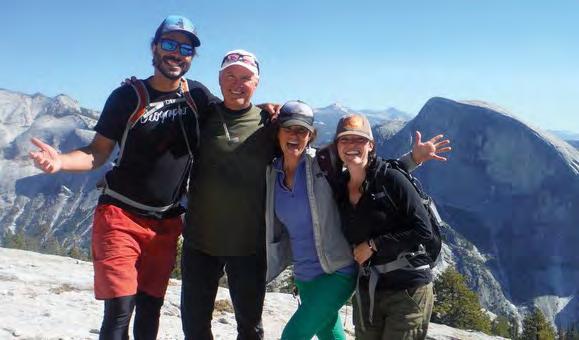
echocoop.com

Tuolumne the best of California in one county!
Feel at home while enjoying your next family vacation. 28 cabins sleeping 2-30; Sugar Pine to Pinecrest and Strawberry. Close to Dodge Ridge, Pinecrest Lake and Yosemite.


pinecrestarearentals.com












































Break out of the daily grind on a Middle Fork American River rafting trip with OARS.
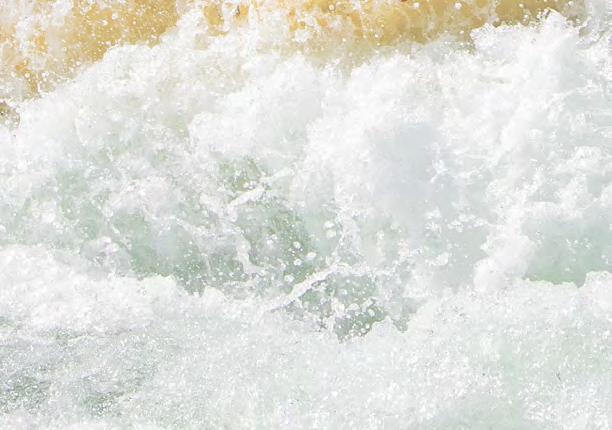


No mind-numbing chores, no screaming deadlines, no boring meetings.

Just you, some friends, a ridiculously fun river and a super-pro guide to keep y’all pointed downstream.

Are you up for the rush?







With a vast beginner zone for newbies, 80+ miles of singletrack to make progression easy, plus some of the most radical terrain in the country, Mammoth Bike Park offers a world-class mountain biking experience for everyone.


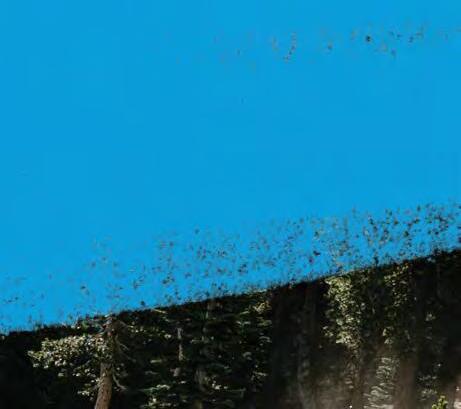








Adventure Sports Journal can’t offer likes, comments, or shares — but we can help you get stoked on outdoor recreation and stewardship in California and Nevada. Sure, we enjoy connecting with people on Facebook and Instagram, but the clickbait articles and divisive comments can be exhausting.


That’s when we like to set our phones down and read an article printed in the latest issue of ASJ. The experience of reading words and seeing pictures on a printed page is more relaxing, more serene, more authentic, and unlike any experience you can find online. That’s what keeps us going.

Facebook and Instagram raked in over $70 billion in advertising revenue last year, to the detriment of independent magazines like ASJ. That’s why we depend on support from companies and individuals like you.
Please support our advertisers and become a member today.






We think ASJ is an important voice for the outdoor community in California. If you agree then consider helping us continue our work by becoming a member today.
Scan the QR code and learn more at adventuresportsjournal.com/membership.

Memberships are as low as $5 per month and include a subscription! adventuresportsjournal.com/membership
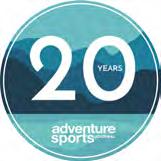




9 Editor’s Note Returning Washoe land // 10 Inbox Letters to ASJ // 10 Ear to the Ground News & notes // 11 Earn Your Beer Hike & bike in Idyllwild // 12 EPiC Indigenous fire management // 29 Race Calendar Upcoming events // 35 Gear



We Love Favorite summer gear
15 Climbing Tips Lessons learned in the outdoors // 16 Rhonda Harper Diversifying the water and surf narrative // 19 Paddling Elkhorn Slough Remembering the importance of wind and weather // 20 Summer Guide Ideas for getting on the water this summer //




22 Crossing State Lines Upper Klamath // 24 Kim Gardner Running towards happiness // 26 Stop the Siren Riders Against Racism
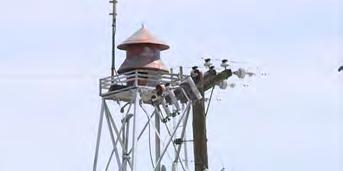
Khadjou Sambe glowing as she hits the waves.

Do you love Adventure Sports Journal?
Do you believe in the power of print and independent media?
Are you a people person who is passionate about the outdoors?
We are looking for the right person to join our team as an independent sales rep. The ideal person would already be working in the industry, with longtime contacts. Previous sales experience is highly recommended, because let’s face it selling print advertising is not easy.
and perks available.
Send your resume and why you think this position is right for you to sales@asjmag.com
PUBLISHING + EDITORIAL
PUBLISHER
Cathy Claesson cathy@adventuresportsjournal.com

EDITOR-IN-CHIEF
Matt Niswonger matt@adventuresportsjournal.com
EDITOR
Michele Lamelin michele@adventuresportsjournal.com
COPY EDITOR
Jennifer Stein jen@adventuresportsjournal.com
EDITORIAL ASSISTANT Taylor Luckenbach taylor@asjmag.com
CONTRIBUTING EDITORS
Leonie Sherman, Matt Johanson, Krista Houghton, James Murren, Brennan Lagasse, Anthea Raymond, Krystal Marie Collins
CONTRIBUTING PHOTOGRAPHERS
Anthony Capaiuolo, Hope Dressler, Rhonda Harper, Khadjou Sambe, Margo Robbins, Marissa Lila, Elizabeth Azzuz, Krystal Marie Collins, James Murren, Cathy Claesson, Matt Johanson, Jesse Rothert
LAYOUT
Cathy Claesson
COVER DESIGN
Lauren Worth
What is the most scared you have ever been in water and how did you get out of the situation?
Sailing down the Big Sur coast into a raging storm, our motor failed. The ensuing rescue took 8 hours and featured a flare gun, a diesel powered bilge pump and a survival-suit clad Coast Guard sailor named Rudy.

Rafting Cherry Creek was quite a challenge, so I put my trust in my expert guide who saw us through.
I was getting pounded in shore break on a huge surf day. I had to dive under and claw my hands into the sand and fight to not get pulled back into the pit. It worked, I lived.
Our raft got tossed in a class V rapid on the Rio Cangrejal in Honduras. A couple of people over the years had died in that rapid. Fortunately, we all were fine and no one was injured, but it put things into perspective real fast.
ADVERTISING
ACCOUNT EXECUTIVE

Cathy Claesson I 831.234.0351 cathy@adventuresportsjournal.com
EVENTS & DISTRIBUTION
Matt Niswonger matt@adventuresportsjournal.com
EVENTS MARKETING
Michele Lamelin michele@adventuresportsjournal.com
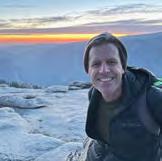


Jennifer Stein jen@adventuresportsjournal.com


Opinions expressed are those of the authors and not necessarily those of Adventure Sports Journal or our advertisers. We usually agree with our articles, but sometimes we don’t. We welcome all contributions.
All content © Adventure Sports Journal 2021. No part of this publication may be reproduced without permission of the editors
ADVENTURE SPORTS JOURNAL
PO BOX 35, Santa Cruz, CA 95063 Phone 831.457.9453 asjstaff@adventuresportsjournal.com

I don’t like banging my head on rocks when I’m upside down in my kayak waiting to Eskimo Roll. That’s scary, even with a helmet.

Agate Beach, Humboldt County. The swell was 20+ feet and the waves were triple-overhead. It was my first foray into a massive NorCal autumn swell. I didn’t understand the true intensity of paddling out that day until I was in the lineup.
Preparing to hit the first horizon line ledge drop on Ti’lomikh Falls (Powerhouse) (VI), Rogue River, for the first time solo captaining my own raft. It was an intense experience.
When I was 10, my family rafted the American River; we jammed up on a rock in Meatgrinder rapids. It was scary but not scary enough to keep me away from whitewater!
Give Lake Tahoe back to the Washoe
The face of outdoor recreation is changing. Whether it’s in the ocean, on the trails, or at the crags, the movement for diversity and inclusion are slowly but surely transforming who participates in the outdoor lifestyle. This is more than just getting underrepresented groups into nature; it’s about sharing the wealth of public lands so everyone gets a chance to sip powerfully from the life-changing cup of adventure.
One important part of this change is the #landback movement. I first became aware of the hashtag after an article was published in the May 2021 issue of The Atlantic recommending returning the management of America’s national parks to Native Americans. Leech Lake, MN Ojibwe tribe member David Treuer wrote the article, and it sparked a viral movement to address our past.
Treuer writes, “We live in a time of historical reconsideration, as more and more people recognize the sins of the past still haunt the present. For Native Americans, there can be no better remedy for the theft of land than land. And for us, no lands are as spiritually significant as the national parks. They should be returned to us. Indians should tend—and protect and preserve—these favored gardens again.” Inspired by this, I began to think about Lake Tahoe. About 78% of the land around Lake Tahoe is managed by the US Forest Service, and this includes over 150,000 acres of beaches, hiking areas, bike trails, and campgrounds known collectively as
the Lake Tahoe Basin Management Unit (LTBMU).
What if the Washoe tribe became stewards of the Lake Tahoe Basin currently under management by the Forest Service? What if we transferred management of this sacred area into the hands of the Washoe? Who is better qualified to care for Tahoe than the tribe that managed this stunning landscape for thousands of years before American colonists forced them into servitude and took their land?
Today the Washoe tribe consists of about 1,500 members living in the vicinity of Lake Tahoe and more are spread throughout the US. There are scientists, land conservation experts and environmentalists within their tribal membership. Coupled with the wisdom of their ancestors, I would argue that these Washoe land use experts can do a better job of managing Tahoe than the Forest Service.
It’s not a stretch to say that Native wisdom has proven effective in modern land management strategies. In Leonie Sherman’s article in this issue of ASJ (page 12), she details how California fire
management has come full circle and now embraces ancient Native intentional burning practices. Again, experience should count for something and Natives have been effectively managing large areas of land for millennia.
Big changes are happening. This is a time in history where people are questioning basic assumptions. The assumption that the Forest Service is better suited to care for Lake Tahoe than the Washoe Tribe should be challenged as well.
With a focus on crop production, the United States Department of Agriculture — which currently manages Lake Tahoe — was founded in 1862 when about half of all Americans lived on farms. As America expanded to the west, the United States Forest Service (USFS) was created in 1905 to “… provide timber for the nation’s benefit.”
With a history of mining, cattle grazing, and logging, the USFS mission has evolved over the decades to include recreation and conservation. In the early 1970s the USFS created the LTBMU. From the USDA to the USFS to the LTBMU what these acronyms

VENDORS
point to is a history of resource extraction and exploitation.
As Americans spread west to pursue our “Manifest Destiny,” history shows we killed the tribes and extracted wealth from the land in the form of gold, silver, salmon and trees. Times have changed, but the same government entities are running the show. With the Washoe in charge of Lake Tahoe, a new agency with a new mission becomes possible. With a history of land stewardship going back thousands of years, a philosophy of connecting with the land could replace the current practice of using the land. The best practices of the LTBMU could be preserved within a better framework by those most qualified to care for the sacred lake the Washoe call “Da ow ga.”
According to the USFS website, “Encroachment” is the term used to describe the process by which the Washoe lost Lake Tahoe to settlers between 1848 and 1863. Supported by the US government, “these settlers claimed land with increasing intensity until 1863 when the Washoe had lost all of their lands in the Lake Tahoe Basin.”
We can’t change the past but we can certainly make better choices for our future and the future of our children. Thanks for reading ASJ. Let me know your thoughts.
— Matt Niswonger matt@adventuresportsjournal.comThanks for your continued support and inspiration. ASJ isn’t possible without you. It hasn’t always been easy, but your help keeps us going.
Thanks for the fun times and opportunities to collaborate. We can’t wait to be together again.
Thanks for making room on your shelves to share ASJ with your customers.
With your support we can continue to inspire adventure, event participation, exploration and


environmental stewardship. — Matt Niswonger & Cathy Claesson
Donations will close the gap needed to create a safer, more enjoyable experience for bikers and hikers descending from the Flume Trail and Tahoe Rim Trail.
The loose, sandy descent at the end of the iconic Flume Trail has long been an issue for mountain bikers and hikers alike. Riders have been known to go over their handlebars due to the deep sand, and conflicts between user groups descending Tunnel Creek from the Flume Trail and Tahoe Rim Trail are increasing in frequency. To relieve the pressure and create a safer, more enjoyable experience for everyone, the Tahoe Fund is launching a matching campaign with the help of one of its donors to help close the funding gap needed to build a new singletrack trail adjacent to the road. Every dollar donated will be matched by the Spaht family until the campaign goal of $50,000 is reached.
Once built, the Tunnel Creek Singletrack will be a 2.3-mile multi-use trail that provides users with a less stressful alternative when descending from the Marlette Flume Trail, the Incline Flume Trail and the Tahoe Rim Trail.
Learn more at asjmag.com/tahoe-fundtunnel-creek-singletrack
This spring, Nevada Governor Steve Sisolak signed into law three bills that directly affect Nevada’s indigenous tribes and communities. The bills included providing free tuition for native students (AB 262), outlawing sundown sirens and racially offensive mascots (AB 88), and transferring management for the Stewart Indian School museum and cultural center (AB 270).
The bill signing was held Friday June 4, 2021 at the campus of the Stewart Indian School, and Gov. Sisolak was joined by tribal elders as well as legislative representatives. Stacey Montooth, Executive Director of the Nevada Indian Commission, stated that the bill signing ceremony was put together in under 48 hours. “I say unequivocally, there has never been a better time to be indigenous, and live in the state of Nevada,” said Montooth.
ASJ and Riders Against Racism hosted a protest bike ride to support the Washoe Tribe and raise awareness about the Minden 6pm siren. The Washoe have been trying to silence the sundown siren since 2006.
About 80 protestors showed up for the peaceful gathering. “May 29th was a special day in Minden. Washoe and Paiute tribal members gathered in the town park with an ally group of mountain bikers to denounce the siren. Stories were shared, dances were had, and collectively the group asked the same thing that has been asked many times before; ‘Stop the Siren!,’” says Brennan Lagasse, Riders Against Racism participant. The protest was followed by a group mountain bike ride from Genoa to Nevada Beach via the relentlessly steep Sierra Canyon Trail. You can read more about the ride on page 26.
Soon after the Protest Ride, Nevada’s AB88 was passed outlawing sundown sirens. Unfortunately, the town of Minden says this does not apply to their 6pm siren. As we go to press, Niswonger along with Marty Meedan are planning another protest ride for July 3, 2021.
Over $3,000 has been raised over the course of the Riders Against Racism 50/50 Challenges and Protest Ride. We intend to raise more funds to support the Washoe and their Outdoor Expedition Program. Read more at asjmag.com/siren-protestride
The 40th Anniversary Death Ride — Tour of the California Alps, originally scheduled for the summer of 2020, is finally returning to Markleeville, CA on July 17, 2021. As many as 2,500 cyclists from across the country will attempt the endurance event covering over 103 miles, six highly categorized climbs, and over 14,000 feet of vertical climbing in just one day.
The ride has been recognized as one of the most challenging endurance events and is steeped in cycling history. This year organizers are unveiling the newest route featuring Monitor Pass (8,314’), Ebbetts Pass (8,730’), and the Pacific Grade (8,050’).
Bringing the Death Ride back to its roots, this year’s event is led by Curtis Fong, founder of Bike the West and director of the Death Ride from 1984 – 1995. Fong has a 28-year reputation of producing high-quality bicycling events at Lake Tahoe.
“The Death Ride has always had a special place in my heart,” says Fong, “having helped start and build it in its early years, and now with the opportunity to once again direct this awesome ride, I feel I have come full circle.”
Travelers on July 17 should note the road closures in Alpine and Mono counties from 5am to 4pm.
Read more at asjmag.com/death-ride-2021
When the 2021 Tokyo Olympics finally commence in July, the outdoor recreation community will be represented by three new outdoor sports added to the Olympic Games — surfing, skateboarding and sport climbing.
A mix of world champions and rookie surfers will turn up at Tsurigasaki Beach, roughly 50 miles away from the Olympic
Happy Anniversary. Much thanks for these years of reporting “the fringe” activities in nature. I appreciate print over digital.
I strongly believe “the fringe” keeps the center in balance, even though there be fewer of us.
God bless the dirt-bags and the solo wanderers of our wonderful country.
David Brooks, FairfaxI come for the woke. Yes, I just saw a letter in your latest issue where a reader takes issue with opinions making their way into the magazine. As a person of color, I am
all for your Diversity Pledge and industry efforts to welcome new people into outdoor sports. As a hiker, cyclist, surfer, climber, and outdoors person in general, I also think that we need more education and support on stewardship, leave no trace, and conservation and preservation as we see more users and new users of our public and wild lands. Finally, your message on maintaining print journalism resonates with me, and I think it dovetails with diversity and inclusion: as sport activities and populations develop and change, the journal needs to grow as well in order to survive. New faces in the field = new readers = new members.
— Tom Stagg, Santa CruzStadium in Tokyo. Japan is not known for quality waves, nevertheless all eyes will be on decorated American surfers John John Florence and Carissa Moore, who respectively have two and four world titles. Australia and Brazil will also send strong contenders.
We predict skateboarding will steal the show at the 2021 Olympics. Both street and park styles will be featured. The sport’s most popular street skater from Davis, CA, Nyjah Huston is a 12-time X Games winner and five-time world champion. He will be challenging for a medal, as will Yuto Horigome of Japan.
Climbers will compete in three sport disciplines: bouldering, lead climbing, and speed climbing. The climbing world has been ambivalent about the Olympic debut of the sport, with some athletes pointing out that they must take part in all three disciplines when most only train in one or two. Speed climbing in particular has caused unease. “The fact that you can climb in five seconds or six seconds has nothing to do with climbing,” Czech climber Adam Ondra, who will be competing in Tokyo, told The New York Times last year.
“It’s a circus.”
Learn more at asjmag.com/olympics
The cultural landscape encompassing Juristac is known today as the Sargent Ranch. An investor group based in San Diego purchased the land at a bankruptcy auction and is currently seeking to develop a 320-acre open pit sand and gravel mining operation on the property.
Juristac (Huris-tak) lies at the heart of the ancestral lands of the Amah Mutsun Tribal Band near Gilroy, California. For thousands of years, Mutsun ancestors lived and held sacred ceremonies at this location in the southern foothills of the Santa Cruz Mountains, above the confluence of the Pajaro and San Benito rivers.
“This is where our ancestors held healing
ceremonies, this is where our spiritual doctors went to prepare themselves for the dances,” says Ed Ketchum of the Amah Mutsun Tribal Band.
Resistance to the proposed mine is ongoing. Your help is needed.
Learn more at asjmag.com/protectjuristac
As of May 2021, wilderness permits are required for all overnight big wall climbers. During this pilot program, wilderness permits for climbers will be free and there will be no quotas or limits on the number of permits available. The pilot program will help climbing rangers better understand use patterns on big walls and increase compliance with existing regulations (e.g., proper disposal of waste), and minimize impacts to wilderness character through improved education.
According to the Yosemite park website, “Yosemite’s big wall climbs occur almost entirely in designated Wilderness — the highest degree of protection available for public land. Both park management and park visitors have a special responsibility to protect designated Wilderness for this and future generations.”
Tahoe Area Mountain Bike Association (TAMBA) leader Amy Fish has stepped down from the board after ten years of service.
In a recent Facebook post she wrote: “This spring I left the @tambatahoe board. The last 10 years of volunteering with TAMBA have been tiring, inspiring, and absolutely awesome. I’m so proud of everything I’ve been able to do and create with these amazing people.”
TAMBA has come a long way in the last ten years because of Amy, her husband Ben Fish, and many others. Congratulations Amy and good luck in all your endeavors.



 By James Murren
By James Murren





Idyllwild is a small mountain town at the foot of Mt. San Jacinto that can be jam-packed full of tourists and vacationers on the weekends, but if you time it right during an off week, the middle of the week can be quite quiet. On a recent trip, I set out in the cool morning air to hike up to the PCT at Saddle Junction via the Devils Slide route, a popular outing. Along the way as I stepped some 2.5 miles with a little under 1,700 feet of elevation gain, spectacular views of Tahquitz Peak and Suicide Rock across the way appeared and disappeared from the forest canopy. PCT thru-hikers bopped their way down the trail, the town being a long-standing refueling spot. Bird songs lifted as the sun reached higher into the sky. Viewing Tahquitz, a wellknown climbing spot in southern California with a history nearing 100 years, I thought to myself: Idyllwild has all you need for a few days to recharge oneself.
On the other side of town there are The Hub trails. No maps exist for them, other than in a few corners of the internet. I had
long heard of the trails, but never really put forth much effort to locate them until this latest trip. Built and maintained by local mountain bikers, they twist, turn, climb and descend in classic cross-country rhythms of yesterday, so to speak. I marveled at what I “found,” declaring to friends via text that they were the best mountain biking trail network in southern California. Up on a ridge trail, looking across to Mt. San Jacinto and having not seen another person for nearly two hours, the day spring-time-warm and sunny with a soft breeze, I experienced a moment of blissfulness. Sometimes things align and the energy feels so good, despite the onset of tiredness, that you tell yourself to push on a little more, riding the stoke a little longer.

At the end of the day, after hiking Devils Slide in the morning and pedaling
The Hub trails for a few hours in the afternoon, I sat on a boulder and had an IPA from the local beer maker: Idyllwild Brewpub. They recently started canning six-packs of it. First impression: it is not a west coast IPA. It is not loaded with hops. My goodness, it reminded of IPAs brewed back east in the 1990s, with a little more malt presence than what we see today in a lot of IPAs. Not really sweet, but something along those lines. I would say it is easily drinkable, especially when sitting in a forest, which I guess is to say: why complain?
When in town, be sure to stop by the brew pub. The patio setting is very relaxing, has a pretty view with all the trees around, a perfect spot to simply chill out. Grub and grog in that setting will satiate more than your belly.
idyllwildbrewpub.com

Catastrophic wildfires burned almost four and a half million acres of California in 2020. A dry winter has residents on edge about what the summer will bring. If we don’t learn to manage fire in the Golden State, we will continue to experience cataclysmic blazes into the foreseeable future.
Fortunately there is precedent if only we have the wisdom to listen. Prior to European contact, California Natives used fire to protect their homes, reduce populations of pests, improve seed germination and enhance hunting. According to Chico State professor Don Hankins, Natives set low intensity fires on 4-12 million acres in California every year. They did this for thousands of years.
California evolved with fire. The Cultural Fire Management Council (CFMC), based on Yurok land in Humboldt County, is bringing back traditional uses of fire to revitalize their ecology, economy and community. As Natives reclaim their right to use fire on the land, California’s 39 million other residents have an opportunity to acknowledge their expertise and learn from their wisdom.
“Our whole world was fire adapted, just like we are,” explains CFMC Fire Coordinator and Traditional Fire Practitioner Rick O’Rourke. “Fire helped the land stay healthy and helped the people stay healthy on the land. It helped us keep balance. Fire is the sharpest tool in our shed for preventing catastrophic wildfires.”
Half of the steep mountainous terrain, extending from the mouth of the Klamath River over 40 miles inland, was traditionally grassland prairie interspersed with majestic oaks and madrone. Natives regularly set low intensity burns to
maintain the prairies, along with their food supplies and materials for basket making.
But burning practices were suppressed over the years. “You can read in letters from the Forest Service dating back to the 1900s, where they were telling rangers to shoot Indians who were putting fire on the land to take care of it,” says Margo Robbins, Executive Director of CFMC. “When I was growing up, setting an unauthorized fire meant you go to prison.” As a result, only 3% of the land is still prairie; the rest is dense forest choked with brushy debris.
A 2012 survey identified returning fire to the land as the most pressing issue facing the community. “There were two main reasons,” explains Robbins. “Basket making, and our elders.”
“Our baskets are the Tribe’s main cultural resource,” explains O’Rourke. “Without the baskets we wouldn’t have been able to survive.”
Traditionally baskets were an integral part of life, used for storage, to transport food and cradle babies. The frames are made from hazel, which needs to be burned to produce the single straight stems used in traditional basket making. Fire exclusion policies resulted in dense brushy hazel with no single straight stems. “The art of basket making was dying out,” Robbins says with a sigh.

“We also wanted to protect our elders and our whole community from wild fire,” she continues.
“We only have one road onto and off of the reservation, so we worried that with the amount of fuel on the land our elders might not be able to escape in case of a wild fire.”
After identifying fire as the community’s most pressing need, interested folks began researching how to legally use fire as a tool to manage land.


“We did our first burn in 2013,” says Robbins. “It seemed like it took forever to get to the point where we could actually burn!
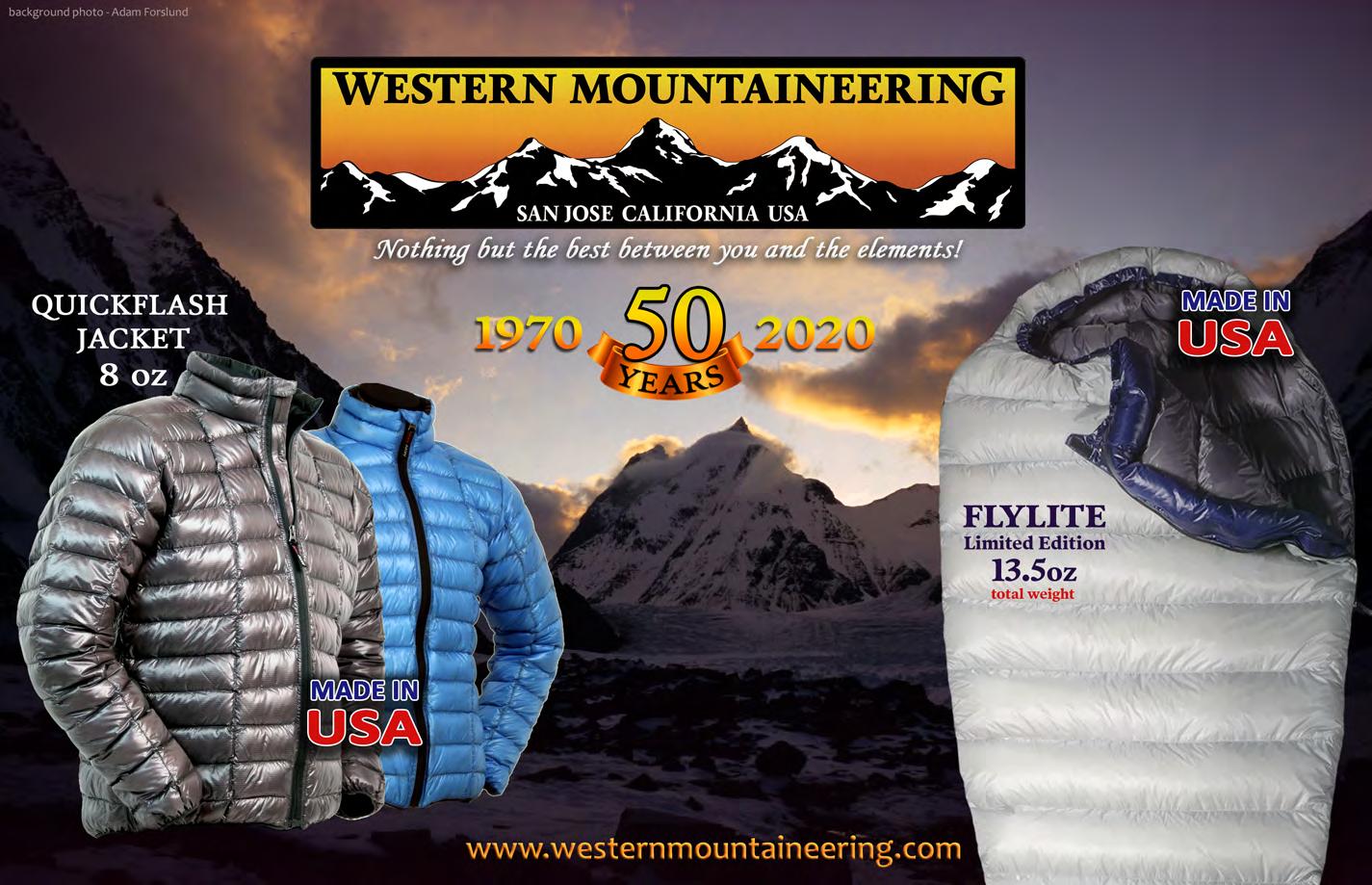
“We had volunteers put a fire line around an area we wanted to burn,” explains Robbins. “We didn’t have any money, so I made a bunch of deer meat sandwiches for lunch, everybody was happy with that, we were just so happy we were going to have hazel sticks for our baskets again.” The initial burn of seven acres took place in the spring; the
following spring there was about a two-week window for harvesting the hazel sticks.
For their first burn, CAL FIRE brought in a busload of prisoners to help keep it under control. “They brought 20 inmates, so I set my goal to train 20 local community members so we could do our own burning,” explains Robbins.
A core group deepened their commitment to reintroducing fire to the land. They got involved with the Nature Conservancy’s Training Exchange

(TREX) program, an experiential curriculum that teaches prescribed burning. Robbins helped set up the entry level firefighting program—32 hours of classroom time and six days of burning. They filled the local community center with eager participants. Their first TREX program burned 67 acres; next year they burned 167. CFMC incorporated as a non-profit in 2015.
Seven tribal members, most of them elders, make up CFMC’s Board of Directors. In addition to Robbins and O’Rourke, they have a fire and fuels reduction crew composed of five people, and six others join sporadically when needed. They recently secured a three-year grant. “People put a lot of trust in us and we take that very seriously,” says O’Rourke.

“You can read in letters from the Forest Service dating back to the 1900s, where they were telling rangers to shoot Indians who were putting fire on the land to take care of it,” says Margo Robbins, Executive Director of CFMC. “When I was growing up, setting an unauthorized fire meant you go to prison.” As a result, only 3% of the land is still prairie; the rest is dense forest choked with brushy debris.ABOVE: FIRE SLOWLY BACKING ITS WAY DOWN THE HILL CLEARING THE UNDERSTORY OF BRUSH AND WOODY DEBRIS (ELIZABETH AZZUZ).
They earn that trust through careful preparation before any burn begins. “When we start on a unit, I try to identify as many threats as possible and mitigate those. Then I ask myself ‘what’s the worst thing that could happen here?’” O’Rourke explains.
“If that risk is too great, we do more work; setting fire lines, raising the understory, removing fuel around legacy heritage trees. We keep working until there’s an acceptable level of risk.”

Not every burn has the same goals.

“In one fire we might be burning for hazel sticks, that’s a lower intensity burn. But another area we might be burning to reduce invasives; that needs more heat,” explains O’Rourke.

“You need to understand your own relationship to fire and what kind of activity you’ll be experiencing during a fire.” Not all of CFMC’s work is with burning; they also remove fuels from the roadside where occasional arson can quickly get out of control.
In addition to their crews, CFMC supports family burning, a traditional approach to fire that empowers the community and safeguards their homes. “Up in Thompson Creek we got permission to burn 12 acres. We got friends and family together, had a little barbecue, and had a little burn,” O’Rourke recalls fondly. “That’s how we do it, building community, being good neighbors, and being fire educated.”
And once they burn an area, regular low intensity burns are needed to keep the land in balance and reduce the risk of a catastrophic wildfire. “It’s easy to start a fire, it’s much harder to hold a fire,” explains O’Rourke. “I don’t even like to call it a controlled burn; that gives you the illusion you’re in control.”

“I know how to fight fire,” he continues. “But I don’t like to fight fire. Fire is one of the sacred elements. We need to fight fire but it’s not a fight, it’s a struggle for balance. The land is already adapted to fire here in California. The important question is, ‘How long will it take to get back to a balanced state? Thousands of years? Hundreds?’ ”
Nobody knows precisely the scope of work that needs to be done, but there’s a lot of it and we all need to be part of the solution or suffer the devastation that comes from inaction. “I feel like people have two choices,” explains Robbins. “They can continue to do nothing and wait for the next catastrophic fire to come, or they can learn to live with the smoke from controlled burns.
“We need to decide what our relationship with fire will look like,” Robbins says. “Will it be massive amounts of toxic smoke that blanket our communities for weeks from catastrophic wildfires? Or will it be the limited amount of wood smoke produced by a prescribed burn? There is no such thing as a no-smoke or a no-fire option.” She pauses. “The good news is that we can decide what fire will look like in our lives.”
“We need to fight fire but it’s not a fight, it’s a struggle for balance.”
— Rick O’Rourke
50 LESSONS IN 50 YEARS // PART 3
“I turned 50 recently and I’m grateful to still enjoy outdoor activities that I picked up in my youth. Following are lessons I’ve learned over the years. This installment, the third of five, focuses on climbing.”
Ascending Cathedral Peak in Yosemite’s Tuolumne Meadows thrilled us. Atop the granite gem, a godly view of the mountainous horizon rewarded my buddy and me. The challenges we overcame to see it made the victory sweeter. That joyful moment made me a lifelong climber. Here are some tips I have learned along the way.

1SAFETY FIRST. Secure your harness properly. Check your partner’s knot and your own. Wear a helmet. These measures go a long way toward ensuring safety.
2USE INDOOR GYMS TO CLIMB MORE AND BETTER. Nothing beats climbing outdoors, but indoor gyms allow year-round and nighttime activity.

3PICK A GOOD PARTNER WHO YOU KNOW AND TRUST. But it’s also good to climb with new people who can help you improve and discover new destinations.
4“FIVE FUN” IS THE BEST ABILITY LEVEL. Climbing doesn’t have to be difficult to enjoy. I got started on moderate classics and still enjoy those the most. Let Alex Honnold
PETZL: EVA FOAM
EXTREMELY DURABLE AND RESILIENT

OTHER BRANDS: EPE FOAM CHEAP
handle the cutting edge. No one has to prove anything to have a good time on the rock.
5GENERAL FITNESS WILL HELP YOU ENJOY CLIMBING WHEN YOU CAN GO. Running, cycling and other aerobic exercise will keep you trim, which definitely helps. Pull ups are the simplest way to improve your ability.
6TIME YOUR OUTINGS TO AVOID CROWDS. Try to go midweek or in the shoulder seasons. If you have to go on prime days, arrive early.
7IF YOU THINK CLIMBING DELIVERS THRILLS, TRY LEADING. Not everyone is suited for this, and one should follow many outdoor climbs first. But when you’re ready, leading a challenging route successfully can make you feel like a climbing rock star.
8BUY GOOD GEAR, EVEN THOUGH IT’S EXPENSIVE. Cams cost up to $100 each but are worth every cent when you’re high above your anchor and need to jam one into a crack quickly. Don’t cheap out on the rope, either.
9IF YOU LEAD AND PROTECT A CLIMB WELL, THEN ACCEPT FALLING AS PART OF THE SPORT To improve, a climber needs to push limits and risk falling. A climber on a top rope should have nothing to fear.
Lead climbers must accept greater risk, but should still fall harmlessly if they prepare and react correctly.

10BE CONSIDERATE. Keep your noise down, pick up your trash and help those in need. It also helps to climb popular routes quickly so others can enjoy the route after you’re done.
Cathedral Peak keeps calling me back. Following my 50th birthday, I teamed up with my cousin to climb it for the seventh time. After the pandemic restricted Yosemite all summer, we enjoyed a glorious autumn day.
I’m looking forward to many more years on the rocks, and every time I see Cathedral Peak, I’m grateful to the majestic mountain for teaching me how to climb and how good climbing feels.
AFFORDABLE HARNESSES. HIGH-END MATERIALS.

Many brands use low-quality EPE foam in their entry-level harnesses. This is the same foam used in disposable packing materials. In every affordably-priced CORAX harness, you’ll find durable EVA foam. The same foam used in hockey pads and other high-impact sporting equipment. This foam maintains integrity and keeps you comfortable for longer.

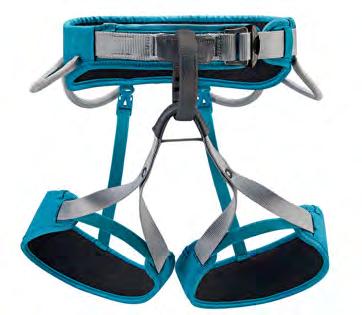
Put on any of our three CORAX harnesses and #ExperienceTheDifference for yourself. www.petzl.com


 By Krista Houghton
By Krista Houghton
Surfing requires grit. Surfing while female and black requires next level grit. Meet Rhonda Harper, the grittiest of them all. Founder and director of Black Girls Surf, Harper knows how to make dreams come true.

Growing up in Kansas in the 1970s, Harper experienced firsthand segregation, discrimination, sexism, and racial injustice. She lived it – every day. This included walking over two miles to the segregated pool to swim. This lack of access to quality pools and lessons left many young black kids unable to swim. Learning to swim was not made a priority for many black children, so the thought of wanting to be a surfer for a young black female was definitely unusual and not part of a normal conversation. Still, Harper dreamed of surfing. She collected surf magazines like a squirrel collects nuts. She was so hooked that at seven years old she started a paper route just to fund her magazine habit. Harper, or “Coach Rho,” is now a long way from Kansas. Her parents moved to San Jose, CA when she was ten years old. Her first visit to the beach was Steamer Lane in Santa Cruz. She was immediately drawn to the cliffs and crashing waves. California beaches were segregated up until the 1960s and Santa Cruz still holds a reputation for localism in and out of the water. She recalls experiencing ongoing prejudice during her visits to the beaches in Santa Cruz. One such incident resulted in a racial slur written in
surf wax on her car windshield. “As a teenager I was angry about that. I wasn’t going to allow people to treat me a certain way,” Harper recalls, and she wasn’t scared to fight back. In fact, her nickname back then was “Rocky” because she liked to fight and got in her fair share of trouble. She now recalls with a bit of pride that she bullied the bullies. “I couldn’t stand seeing someone pick on the littles.” Perhaps it was in her DNA to stand up for the underdog.
Regardless of young Harper’s intentions, her mom did not condone the behavior and warned her daughter, “You’re either going to end up in jail or end up dead unless you change.” And soon thereafter, put 15-yearold Harper on a plane to Hawaii to live with her sister who was studying at Chaminade University on the North Shore of Oahu. Her parents hoped that being close to the ocean would mellow her out. “I brought over a suitcase full of surf magazines, hundreds of them. I would watch all the surf movies growing up, like Beach Blanket Bingo and just dream of that life,” she says.
Harper recalls a nearby bench in Oahu that still exists today. “I would sit on that bench and watch the waves and water for hours. I felt like my Hawaiian dreams had come true; it was a pinnacle moment for me.” It was 1984, and at the time Harper was the only female African American to attend Waialua High. There, she took a course in Hawaiian History. “I was shocked to learn that it was the Hawaiians that invented surfing. I went home and took every photo of white surfers off my wall.”
Being in Hawaii with so many brown surfers gave Harper a sense of belonging. “I would watch people of color surfing and think, if they can do it, I can do it.” So, she taught herself how to surf on the North Shore
THIS PAGE, TOP TO BOTTOM: KHADJOU SAMBE AT LONG BEACH, CAPE TOWN SOUTH AFRICA (RHONDA HARPER); IT’S ALWAYS A GOOD TIME WITH COACH RHO (KHADJOU SAMBE PHOTOGRAPHER IN THE BACKGROUND).
of Oahu, the most coveted, gnarly, and revered area for surfers in the world. “I love the hard fall,” she says, with a slight chuckle in her voice. “When I’m under water getting hammered, I’m smiling, I’m loving it.” She credits her toughness to growing up in segregated Kansas, the daughter of activist parents. Her mother worked for the Equal Employment Opportunity Commission and her dad for the unemployment office, helping black vets. Her father would always say, “If they don’t have a job for you, you create it.” Harper praises her parents for giving her the tools and strength it took to create Black Girls Surf in 2014.
Being in Hawaii with so many brown surfers gave Harper a sense of belonging. “I would watch people of color surfing and think, if they can do it, I can do it.”
TOP

MUIZENBERG (RHONDA HARPER); GOOD FRIENDS AND GOOD VIBES, COACH YANI TROUT OF NEXGEN SURF (PROVIDED). SECOND ROW, LEFT TO RIGHT: BLACK GIRLS SURF MINIS, CROSSROADS TOWNSHIP IN CAPE TOWN ENROLLED 60 GIRLS IN ONE DAY (RHONDA HARPER); BLACK GIRLS SURF LAUNCH IN CAPE TOWN, SOUTH AFRICA (RHONDA HARPER).




learn what the judges were looking for and why certain surfers got more points than others. I wanted to figure out
Fast forward to 2014 when Harper says she “got her
This new trail will be adjacent to the current road. It will separate hikers from bikers and provide a safer way to finish the world-famous Flume Trail. Thanks to a matching gi from the Spaht family, every dollar donated will be matched up to $25,000. Visit: tahoefund.org/tunnelcreek
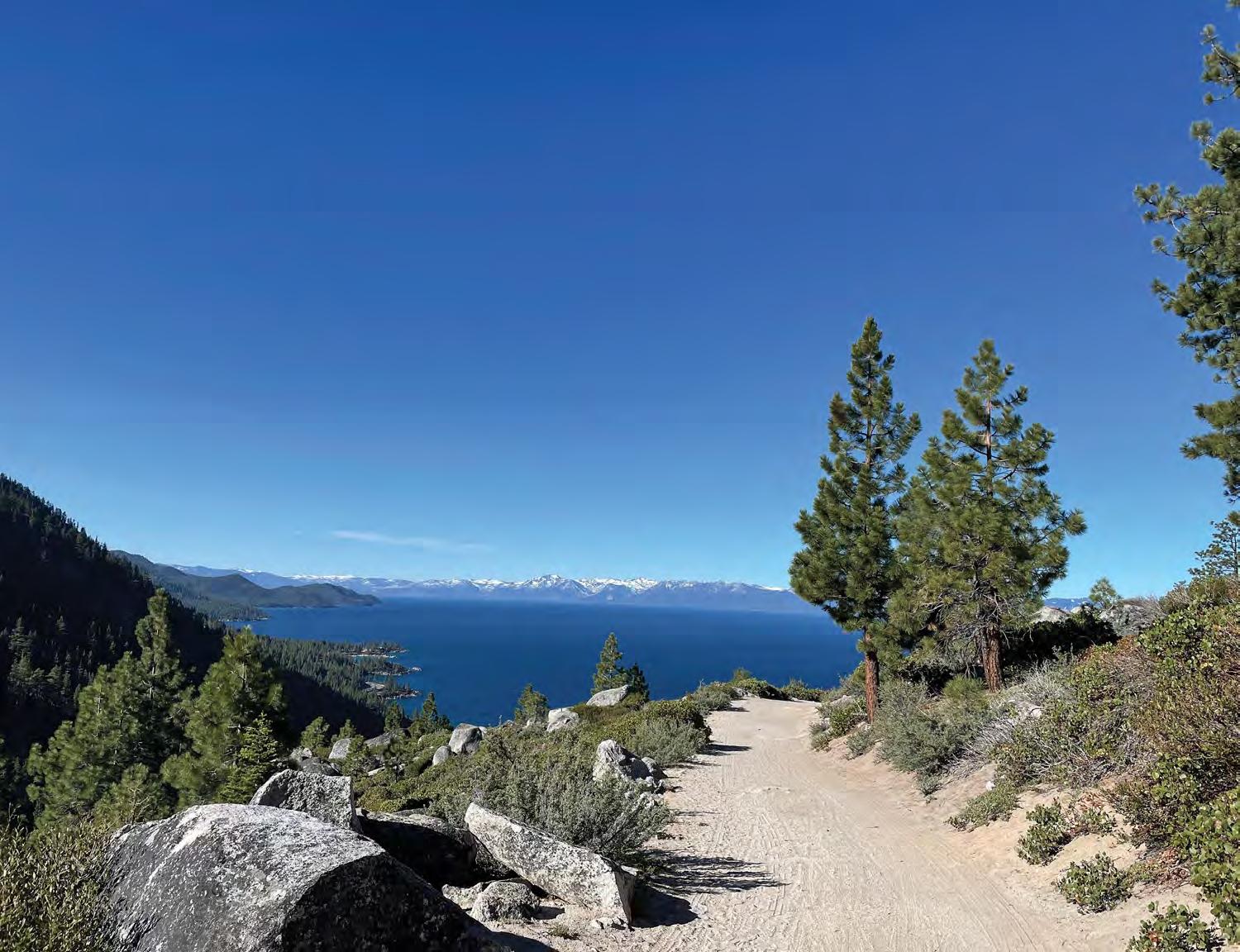
CLOCKWISE FROM TOP: SAMBE INSTRUCTING THE BGS MINIS ON SURFBOARD BASICS (RHONDA HARPER); COACH RHO’S DAY OFF — WHEN TRAVELING SHE IS KNOWN TO VISIT LIGHTHOUSES AS THEY REMIND HER OF HOME (PROVIDED); LENDING A HELPING HAND IS A WAY OF LIFE (RHONDA HARPER).


hands dirty.” She got together with a fellow female black surfer and organized a competition to showcase black surf talent in Africa, calling it “Black Girls Surf.” When asked why she picked Africa she doesn’t mince words: “Where else could I find more than one black female surfer?” She does have a point. In my 26 years of surfing in America, I have only surfed with black women on a handful of occasions.
It took years to plan the competition, and their efforts were hampered by pushback from the very industry that is now embracing change. Then, the 2016 travel ban hit and put more roadblocks in their way. In 2017, it was on, but only one female was on the roster. She went to the ISA and the World Surf League (WSL) hoping to find female surfers of color, but there were none. So that’s when she started Black Girls Surf camps, so she could find, enroll, and coach black female surfers for the WSL. Living true to her father’s words, “If you can’t find it, create it.”
I asked Harper if she felt the Black Lives Matter protests in the wake of George Floyd’s murder last year shed more light on her efforts. “I’ll take whatever I can get. It’s been a long time coming and it’s finally here.” She is right. Big companies and organizations like Hurley and the WSL are now sponsoring Black Girls Surf. This support saves Harper from using her Coast Guard pension to pay for contest fees and travel. More than that, it is a sign of change, progression, and
empowerment in the lineup.
Harper plans to have twelve camps up and running in West Africa and California. Most recently she was focused on 2021 Olympic hopeful Kadjou Sambe (featured on our cover). Harper discovered Sambe in 2016 during an online search for female black surfers and the two clicked. They spent this past year training in the cold waters of Santa Cruz but were unsuccessful in making the team. Her goal in four years is the Olympics and to have her female black athletes on the team. I pried a little deeper and asked what really gives her joy and keeps her pushing. She shared that recently a South African female prison asked to enroll some inmates as part of a new prison reform program. Harper shared that both her parents worked on prison reform issues and that she is deeply moved by the potential to help these women through surfing.
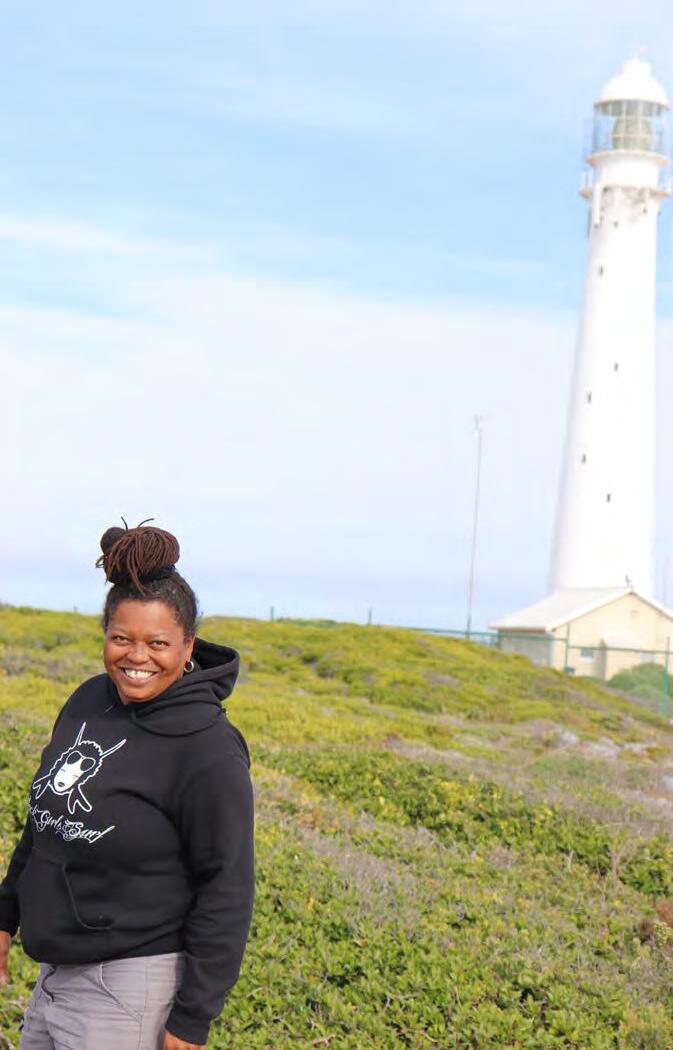
Can you imagine the NBA or NFL without black athletes? Of course not.
So why is surfing different? It’s all about the lack of access. For too long, black kids have been denied access to pools and denied access to beaches. They have also been denied representation in surfing magazines that traditionally only featured white guys and white girls in bikinis.

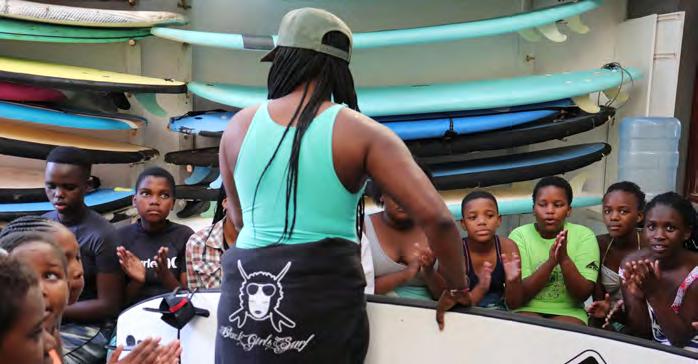

Luckily, things are starting to change. From blonde babes to dark skinned beauties, we all should be able to share the ocean and thrive. A true evolution of surfing has begun.

My love affair with stand up paddle boarding (SUP) began some years ago. From my very first SUP adventure at Sand Harbor on Lake Tahoe, I was hooked. I could see all the way to the bottom of the lake and moving over crystal blue water was like a dream.



To date, I have now been to numerous rivers, lakes and ocean adventures on an SUP, even a waterfall. I have been visited by dolphins, turtles, seals, rainbow trout and even a Hawaiian owl.
So, when my sister and group of friends wanted to SUP Moss Landing, I was eager to join. Moss Landing is home to Elkhorn Slough, one of the top ten wildlife viewing destinations in North America. This slough is home to a variety of birds and seals, and happens to be one of the best places to view sea otters.

On a slightly chilly morning in May, we met up at The Kayak Connection where they outfitted some friends in boats. Great folks with a great launch. Within minutes of setting off, we were greeted by a friendly pack of harbor seals as a flock of pelicans soared overhead. The water was so clear I could see the sand dotted with seaweed on the bottom.


Gently being pushed by a breeze from behind, we glided easily into the estuary. I knew the ease of paddling at the beginning can be deceptive. The tide was going low (a negative 1.0) that afternoon and the month of May usually ushers in the predictable afternoon winds.



At that same moment I also recalled a few of the not so easy adventures I have had on an SUP. One was a supposed “easy” paddle across Hanalei Bay in Kauai, which turned into a 30-mph headwind and 5-foot waves. Another was a family SUP paddle with my sister and her son at Donner Lake in the Sierra. The wind turned on like a
always a bad idea, just that for us the problems outweighed the benefits and for that reason we encourage kayaking at the Slough instead of using SUPs.” Even though I loved SUPing in Elkhorn Slough, this paddle was a good reminder to always check conditions with a local shop before heading out. Flat water paddling has a low barrier to entry for newbies, but be aware conditions can change on a dime.


 By Anthea Raymond
By Anthea Raymond
HOP ON A HOUSE BOAT
Houseboating has always intrigued us. For a day trip, we like the “patio boats” at Bridge Bay at Shasta Lake. These flat platforms are ideal for cruising the state’s biggest reservoir for a picnic and swim. The California Delta near Stockton is also popular and a distinctive place for multi-day trips. Unfortunately, the briny water mix of fresh and salt water there takes its toll on equipment, leading to Bridge Bay closing its rentals there a few years ago. Try VRBO or AirBNB for a rental if you’re really keen.

THIS PAGE, CLOCKWISE FROM LEFT: HOUSE BOATING (BRIDGE BAY AT SHASTA LAKE); PADDLERS ON EAST BAY ESTUARY (CALIFORNIA CANOE & KAYAK); A CURIOUS HARBOR SEAL (EMMA LEVY / KAYAK CONNECTION). OPPOSITE PAGE, LEFT THEN TOP TO BOTTOM: LA RIVER (MARIA TERESA GIANCOLI); SURFING MONDOS (LOVEWATER SURF SCHOOL); PADDLING BIG BEAR LAKE (VISIT BIG BEAR); SOUTH FORK AMERICAN (RAFT CALIFORNIA).
Estuaries form along the coast, where sea and fresh water mingle, creating a unique habitat. California has a number of them, with the Elkhorn Slough off Monterey Bay being one of the biggest. It is also home to the state’s largest population of sea otters. Seven hundred species of plants and animals live on the protected flats of the slough, making it the place for wildlife viewing. Mornings are a good time to beat the wind and it is never a bad idea to check the tides as well. Try Kayak Connection or Monterey
Bay Kayaks (MBK) — both rent kayaks for a paddle up the slough, as well as unique guided tours: three hour tours, bird watching, SUPing and moonlight paddles to name a few.
The East Bay Estuary on San Francisco Bay is a scenic option, with long marshy flats and a view of the bridge. California Canoe and Kayak at Jack London Square in Oakland is now open for rentals. And don’t overlook Southern California’s Upper Newport Harbor. It too has much to offer, though the shorebirds sometimes

California’s drought is now officially “mega,” with fire risk at an all time high. Rivers are running dry and lakes will be low, but don’t give up hope. There are still plenty of ways to hit the water in style.
have to duke it out with the passing boats. Paddle deep into the harbor though, and it’s tranquil and secluded. Southwind Kayaks has a location right on the bay for rentals.
Lounge Lakeside
California has thousands of lakes, so it’s not quite fair to single out one or two as summer destinations. In Southern California we love mountain lakes like Big Bear and Silverwood. We also like Silver Lake and June Lake in the Eastern Sierra near Ansel Adams Wilderness.


Best to head out soon though. Even in the wettest of times, lakes are prone to algae blooms; not sure what will happen in a mega-drought. The blooms can be toxic, especially to pets. Make sure to check water quality, take posted warnings seriously, and if necessary avoid water contact for you and your pup.
LA’s the Place
Los Angeles is known as a beach town, but it began as a pueblo next to a river, the Los Angeles River. Long neglected, the river is now seeing a renaissance, with a world-class park, a greenway, and a cultural center among the amenities planned for its banks. The riverbed itself is still mostly concrete to help it control flooding, but in two sections wildlife and plants thrive. Now in its tenth year, kayaking these sections of river has become an Angeleno rite of passage.
Visitors love the verdant surprise that awaits them too. In the summer months LA River Expeditions runs guided trips on both these stretches, and has a long history as a steward of the area. LA River



on

Ready to test out a longboard or SUP in the surf? Summer is a prime time to hit one of California’s baby beach breaks, with warmer water and breezes. We love Mondos in Ventura County for its long rolling waves, friendly vibes and easy parking. Some call it the Waikiki of California. You’ll even see boogie boarders there.
Bolinas, north of Stinson Beach in Marin County, is another newbie favorite, though you’ll park in the neighborhood and walk to the break. Both these spots “work” best at mid-tide, and do fine with the south summer swell. If you’re wanting instruction, Lovewater Surf School loves Mondos too. Bolinas Surf Lessons has it covered in the north.
Summer wouldn’t be summer without a little splish-splash in a raft. Conditions are changing daily for many outfitters. At least one worries they might shut down by mid-July due to lack of water. But one reliable go-to for a good time is the South Fork of the American River. Planned recreational releases there make flows predictable and consistent at least on weekends and several weekdays. You’ll have many options for Class III-III raft trips
– OARS, ARTA, Raft California and River Runners to name a few – though camping in the area is more difficult. When really stuck, we stay at the KOA near Route 50 in Shingle Springs.



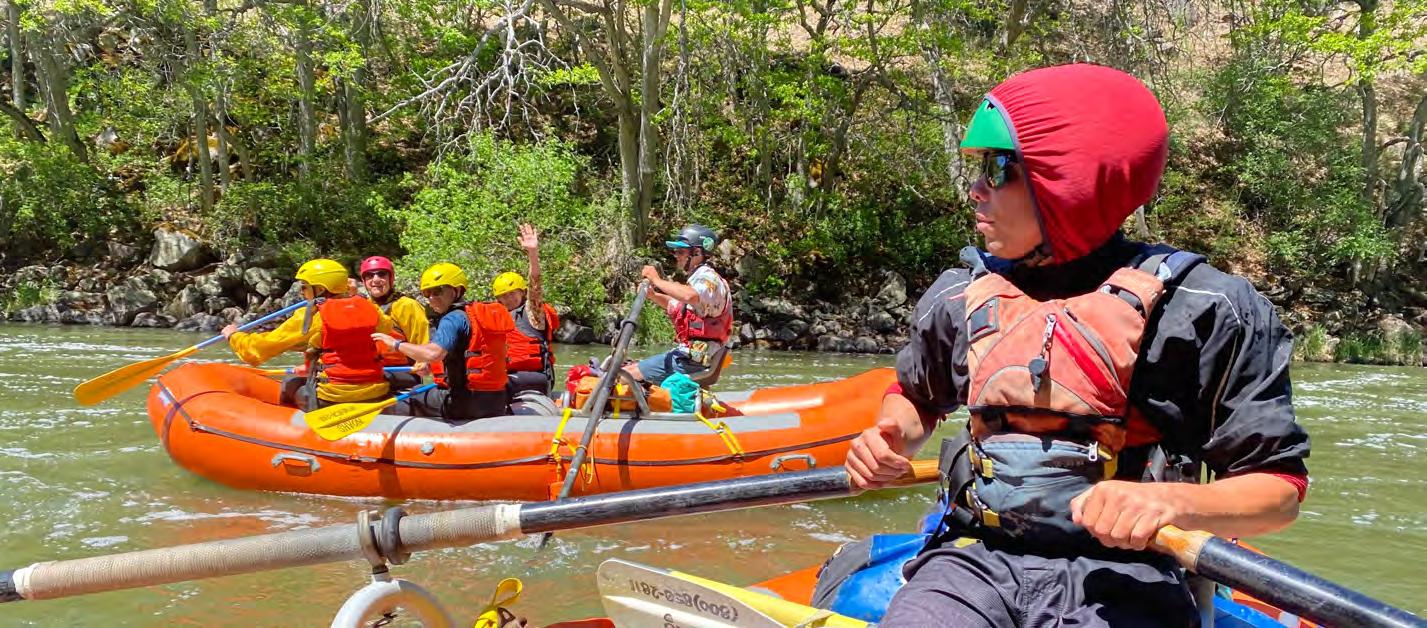 By Krystal Marie Collins
By Krystal Marie Collins
Lying on the deck of the raft, below the captain’s seat, I looked up at the oar grips rowing themselves, then to the backs of my passengers. In a split second, I wondered to myself, “Does this count as ghost boating?” Crashing through each ledge drop in Scarface Rapid (IV), on the Upper Klamath River (UK), it felt as if our five pack was free falling down a steep staircase in a cardboard box or laundry basket. I tried to get back in the saddle while everyone was none-the-wiser. I got bucked right back down. My boss and the other guides in the boat eventually turned around to see my folly. This was not the high note I was hoping to leave everyone on as we pulled over in the lunch eddy below the rapid.
As my cohort spread mustard on sourdough, and I ate a salad wrap, I reflected on our obvious differences. Although I like to think of myself as being in my peak physical prime, entering guide school at 37 years old is an obvious red-flag indicator of an early onset midlife crisis. Anyone my age in the group had already been guiding for fifteen plus years. Any greenhorns were at least a decade younger than me. I watered down these truths by reassuring myself that while the Upper Klamath was by far the biggest whitewater I’d ever navigated from the captain’s seat, I had a lot to offer the group in years of experience as a private boater.
After my internal monologue pep talk, I picked myself up by my bootstraps, dusted myself off, and got back into the boat.
Still, the embarrassment of my lackluster showing on Scarface stuck with me through the next face-off — Snag Island Rapid (Class IV). Coming
round a blind left corner, I was trying so hard to hug the left bank, I forgot to mind my downstream oar. Like a vertical clothesline, the oar caught on one of the seemingly infinite shallow entrapment rocks, stuck and nearly buckled. Yikes. Through no skilled maneuver of mine, like making slop pockets in the game of pool, we broke free and made it through the rapid.
On my second round on the UK I rowed the bulk of the commercial stretch but not the meatiest Class IV+ section in the middle. By this time, I had improved a lot. I didn’t have any seat ejections, kept my hands on the oars and paid a lot more attention to my downstream blade. Even though most boaters only talk about running the meat on the UK, (i.e. Caldera, Satan’s Gate and Hell’s Corner Rapids), I count myself lucky to have experienced rowing any of it.
The removal of the John C Boyle Dam which governs daily flow control on the Upper Klamath, has been greenlighted for demolition in 2023. This
dam removal, along with three others along the Klamath, is touted as the biggest in US history, according to the Earth Law Center.
DAM COMPLICATED
Balancing on the border of Oregon and California, known as the “Everglades of the West,” the Klamath wetlands, basin and watershed is home to mule deer, elk, pronghorn antelope, cougar, black bear, river otters and over 400 other wildlife species. More than 75% of migrating birds on the Pacific Flyway use the basin as a stopover.
The section boated commercially on the UK, although dam controlled, boasts a Wild and Scenic Rivers designation from the put in at Spring Island day use site through to Stateline Falls Rapid (Class III), the marker between Southern Oregon and Northern California.
In its entirety, the river flows 257 miles from the Oregon desert into California and the Pacific Ocean, crossing through

THIS PAGE, TOP TO BOTTOM: RIVER GUIDES BIDE THEIR TIME ON THE UPPER KLAMATH BEFORE DAM REMOVAL SLATED FOR 2023 (KRYSTAL MARIE COLLINS); THE AUTHOR BEHIND THE OARS, BEING TAKEN TO TASK BY THE UPPER KLAMATH (BRANDON SWEET). OPPOSITE
PAGE: PASSENGERS AND GUIDES WITNESS A MAJESTIC DOWNRIVER DEER CROSSING ON THE WILD AND SCENIC UPPER KLAMATH (KRYSTAL MARIE COLLINS).
tribal lands. Through time immemorial, tribes like Yurok, Karuk, Hoopa, Shasta and Klamath have fished for Chinook, Coho, steelhead, cutthroat trout, green and white sturgeon, and Pacific lamprey. They have depended on the river for physical, spiritual, cultural and economic nourishment.
In its entirety, the river flows 257 miles from the Oregon desert into California and the Pacific Ocean, crossing through tribal lands ... They have depended on the river for physical, spiritual, cultural and economic nourishment.


































In its headwaters, the Klamath contains some of the largest rainbow trout in the world. Dams set for removal along the Klamath River corridor have significantly muddied the water (literally and figuratively) and block 300 miles of historic salmon habitat.
To bring together dynamic Klamath Basin stakeholders, the Klamath River Renewal Project (KRRP) was forged and the Klamath Hydroelectric Settlement Agreement (KHSA) was created. The first step of the KHSA is dam removal.







“The KHSA is supported by governments, tribal nations, irrigators, fishermen, and conservation groups ...” explains the KRRP website. “One area of broad agreement in the Basin is that more robust runs of fish will benefit virtually every sector of the Klamath Basin – agriculture, tribes, tourism, recreation, conservation interests, recreational and commercial fishermen, the local economy and the ecosystem as a whole.”


Two of the four dams slated for removal were built over fifty years ago (which is the generally accepted life expectancy of a dam); the other two are over 100 years old. Damming on the UK began in service first to mining booms in the 1850s, and in the 1870s, wetland draining and diversion practices started to meet settlers’ agricultural and homesteading needs. Desired outcomes with dam removal include restoration of traditional salmon runs and elimination of ongoing toxic blue-green algae bloom issues.
Rafters have mixed feelings. Like clockwork, every day between 1011AM a release from JC Boyle and Powerhouse moves water levels from






400 to at least 1,600 CFS (cubic feet per second), if not more. These releases allow the section to be consistently commercially rafted throughout the season. Where most commercially rafted big water day trips on the Kern, Trinity or American are dependent on natural water-shed processes, the UK is essentially a dynamic irrigation ditch controlled by someone pushing a button.
Without these releases, flow will be controlled by snowmelt and rain. The highest flow potential will be in the spring tapering into the summer. The consistency of guiding daily trips on the 1,600 CFS needed to accommodate the whitewater experience being sold will not be possible. Instead, some outfitters have discussed shifting permits and operations to cater to fishing. The Wild and Scenic Upper Klamath will likely be raftable for at least part of the year, but it’s uncertain what the ceiling for flows might be, and if Caldera, Hell’s Corner and Satan’s Gate will ever take their once mighty shape.
Noah’s River Adventures raft guide, Trevor Fulton has this to say: “I’d say the dam removal is bittersweet. It’s unfortunate that we’re losing an amazing section of consistent, yearround class IV, but if it cleans up the water as much as they say it will, then it’s probably worth it.”
As a paddler, I don’t lament the loss of these dams or the associated Class IV+ whitewater. I am a whitewater nomad, a free agent, unattached to any one waterway. Besides, who can deny that the nature of river profiles is to shift and change, with or without dams? While we might try to control rivers in the short term, in the endgame we are powerless — sometimes the oars slip out of our hands. The river is indifferent to stakeholder needs. And that is the definition of Wild and Scenic.

Six years ago Kim Gardner was a rock and ice climbing physical therapist with advanced degrees and a new boyfriend. These days, reading gives her an excruciating headache. Socializing for a few hours makes her nauseous for days. Struggling to decipher a food label can make her cry.
So she runs. Her life follows a simple repetitive pattern: eat, run, stretch, sleep, rinse and repeat. In the first four months of 2021, she ran 1,382.7 miles. In winter she runs the barren slopes of the Inyo and White Mountains. When the snow melts she heads for the alpine splendor of the High Sierra. In the first two weeks of May she climbed Irvine and Thor twice, Carillon five times, as well as Whitney, Langley, Cirque, Keeler, and Barnard. By the middle of June, she’ll have climbed a million vertical feet.

She doesn’t follow a training regimen, pursue sponsorship or compete professionally, though her endurance and fitness place her in an elite league. She runs until the daily headaches and nausea fade, until the clarity of mountain air overcomes her constant pain.
On November 30, 2015, she lost control skiing at Mammoth Mountain and tumbled over some cliffs, planted her poles and slammed her nose right into one of them. She woke up

sprawled in a pool of blood and got backboarded off the mountain. It was her first season on skis. She felt nauseous and disoriented for days.
But Gardner grew up in Michigan, on the Upper Peninsula. “Midwestern people, we just don’t show pain or weakness, we are tough,” she explains. “My dad would always say ‘Don’t take me to the hospital until I’m dead.’” Steeped in a culture that glorifies getting back on the horse that threw you, Gardner started skiing again as soon as she could.
In mid-January 2016, she hit her head again skiing. Ten weeks later she had another ski accident, another knock to the head. In May 2018 while running talus she fell into a boulder well and hit her head. A year later she fainted in a bathroom and hit her head on the porcelain toilet. Three concussions in three months. Five in less than four years.
Medical professionals are still learning about concussions and their long term consequences, but they all agree that hitting your head multiple times before
the brain has fully healed increases the chances of lasting brain damage.
Five and a half years after her first concussion, Gardner’s eyes still don’t track properly. “When I have to use my vision for anything within an arms length, it hurts my brain,” she explains. “Socializing, taking notes or reading, all these things I used to love doing, now they give me a hangover that can last for days.”
It’s not just her vision; Gardner has hyperacusis, or noise sensitivity. She’s lost the ability to filter out background noise, so if she has to stay in a city, the sound of a neighbor’s AC unit will keep her awake at night. Quiet noises are painfully loud for her, so when someone talks to her in a normal voice it sounds like they’re yelling. This makes spending time in town overwhelming and painful.
After her third concussion, when her symptoms weren’t going away, Gardner sought help: doctors, specialists, therapists, hyperbaric oxygen treatments. Nothing worked.
“It was very depressing, constantly
TOP TO BOTTOM: KIM GARDNER JOGGING DOWN THE SOUTH SLOPES OF MT BARNARD ON A POINT TO POINT ROUTE, STARTING AT SHEPHERD PASS TO WHITNEY PORTAL, UP AND OVER MT TROJAN, MT BARNARD, MT TUNNABORA AND MT CARILLON — THE OUTING WAS 24.67MI,12,608’ VERTICAL GAIN VIA RUGGED CROSS COUNTRY TRAVEL AT SUSTAINED ALTITUDE WITH BARNARD TOPPING OUT A FEW FEET SHY OF 14K. (JESSE ROTHERT); GARDNER AT THE SUMMIT OF MT STRIPED, ON A DAY SHE WENT ON TO SUMMIT MT GOODALE & MT CARDINAL — 21.1MI, 10,640’ VERTICAL GAIN (SELFIE).
being told what’s wrong with you,” she admits. “I went through several years of suicidal depression, from 20162019. I don’t really remember a lot from that time. My boyfriend would have to babysit me sometimes. I call that period the dark years.”
In the fall of 2017, with her boyfriend’s encouragement, she started running.

“It was a way to grieve and to cope with the loss,” she explains. “At first I would sprint, and then huff and puff and feel like I was dying. Now it’s more like jogging. I think walking is a little boring. As my fitness improved, I just started running and then I didn’t want to stop.”
And in February of 2019, she began studying psychology. She would listen to podcasts, sometimes hundreds of times, until she could understand them. “I pulled myself out of depression by learning about myself, quieting the inner voice, learning that I can quiet that inner voice,” Gardner says.
“On July 1, 2019 I decided ‘I’m going to be happy,’” Gardner explains. She started logging her runs, keeping track of distance and elevation. This daily task satisfied her obsession with numbers and gave her something positive to focus on.
But while scouting a run in December 2019 her nausea increased. Back in her car, she woke at 1 AM with excruciating abdominal pain and started projectile vomiting. A friend drove her to the ER. “The surgeon came in and said I could either die in a couple hours or I could do surgery,” she recalls. But this
time, it didn’t have anything to do with concussions. Her colon was twisted, causing a complete obstruction. They removed half of it.
“When they did the surgery they realized I have a genetic mutation so part of my colon isn’t even attached to my abdominal wall, it was just flapping around in there!” she laughs “The whole time I was running, I felt like there was a bowling bowl rolling around in my guts. I thought that was normal. Now I know what it feels like to run without that bowling ball. It feels wonderful!”
Friends and family rushed to her side after the colon surgery. “When I was recovering in the hospital I felt really loved,” she admits, tenderness creeping into her voice. “I never really accepted my brain injury until then; I kept comparing myself to my former self.”
Somehow having half her colon removed helped relieve her intense psychological distress. “For the first time, I truly accepted everything, especially myself. Sometimes I stutter my words, or try to hang out with someone and can only cry. Now I just accept myself, that’s me, that’s who I am.”
Like others who come near death, the experience taught her to value life. “I realized you don’t have control over when you die, but you do have control over how you live,” Gardner explains.
“I’m never going to be a doctor or have the same cognitive skills I had before.
I didn’t realize my concussion was serious until the doctor entered the room, dimmed the lights, crouched in front of me, and started speaking in a gentle hushed voice. Fourteen hours earlier a rogue surfboard clocked me in the head. I crawled out of the water, dripping blood, rode my bike home, tried to do yoga and collapsed on a friend’s couch. The next morning I had a black eye. The guy I was dating dragged me to the doctor. I can’t remember the doctor’s name, or what month it was, but I remember what he stressed over and over in that earnest whisper. “You cannot hit your head again for a year.” After decades of damage, organized sports are finally starting to recognize the impacts of repeated concussions on players. I don’t hear outdoor adventurers talking about concussions – yet. But all our sports carry this risk. Many of us place a high premium on not letting our injuries slow us down. But ignoring a concussion can have life-altering consequences. And not all doctors take the time to make sure their concussed patients understand the stakes.
So if you ever hit your head (again), promise yourself these three basics:
1. I will stop and let the adrenaline drain from my body before I act, so I can assess the damage.
2. I will make every effort to avoid hitting my head again for a year.
3. If I’m confused or nauseous, if my pupils are unevenly dilated, if I slur my words or display erratic moods, I will tell someone I trust and let them make the rational decisions I may not be capable of.

To go back to a situation where I’m less than I was before is not an option,” she says. “Being in the mountains helps me feel normal, successful, it gives me a sense of purpose. I can improve, I can eat better and train harder and get better at what I’m doing.”
Ultimately, Gardner has realized that by eliminating activities that trigger
pain, she creates space to learn about what brings her joy. “I’m not running away from anything, I’m running towards something. I’m running towards happiness,” Gardner explains. “If I were to die tomorrow would I regret something? Yeah, I would regret if I took a rest day. I just want to spend my time in the mountains until the day I die.”
“I realized you don’t have control over when you die, but you do have control over how you live.”
 By Brennan Lagasse
By Brennan Lagasse
Switchback after switchback, the trail climbs continuously as it snakes its way up Sierra Canyon. It’s hot and dry in the desert. The riparian greenery around a nearby creek offers brief reprieves of shade. The climbing feels endless, most likely because it’s my first real mountain bike ride in months, or even more likely because I’m going the wrong way on a classic downhill ride for over 4k+ vertical feet.
Thankfully, I’m not alone, and the camaraderie within the group is powerful enough to make the arduous effort feel like I’m going the right way as there is a deeper purpose attached to this ride. The pedaling remains ruthless for hours, but I knew that would be the case when I chose to sign up for the Riders Against Racism ride that took place in Minden, NV on May 29, 2021. It was my choice to join the ride and protest that day, just as it remains a choice for the town of Minden to continue to blare its sundown siren every evening at 6pm.
The Minden sundown law became a reality on April 5, 1917 when a town ordinance went into effect requiring all Native people to “leave and be out of the town limits of Gardnerville and Minden by the hour of 6:30 o’clock P.M., of each and every day.” The siren would go off to support the ordinance and served as a daily reminder that Native people in the area were treated differently simply because they were Indigenous. The ordinance was crafted by white settler-colonialists who established Minden in 1905 with a vision of a European inspired community that would be organized around a town square, the Minden Park. The siren, located right outside of the park continues to go off to this very day. Washoe Elders are still able to recall the time when the sounding of the siren meant they had to leave town. The ordinance stating Native people had to leave town remained in effect until 1974. Town managers for Minden have long defended the siren stating

that today the siren goes off as a test so that local volunteer firefighters know it is still working. For some residents it’s now known as part of the area’s emergency response system, or as a way to honor first-responders, or for some simply as a nostalgic sound of their childhood. All of these ambiguous claims are used to argue the siren is therefore not associated with the sundown ordinance of 1917.
On May 29th, when Riders Against Racism mountain bikers joined members of the Washoe and Paiute tribes on their ancestral lands in the Minden Park, a Minden local named Matt Bernard spoke to the crowd. He said local residents have nothing but love for the Washoe tribe, and as evidence he pointed to a plaque in the park that honored Washoe people who had served the country in war. In one breath it seemed Bernard was paying respect to the Washoe and justifying the siren at the same time. “I want everyone to know that the people of Minden don’t have any animosity, they only have love for the Washoe.”
It was a confusing moment at the gathering. Bernard seemed to be understanding of the undeniable fact that for some residents of the area, namely the Washoe and Paiutes, the siren was a daily reminder of the historical trauma and oppression first peoples of the area are forced to deal with as it continues to ring nightly. But in another breath, near the end of his time speaking, he said the county will simply continue ignoring any resistance towards silencing the siren even though Assembly Bill 88 was recently signed by Governor Steve Sisolak, a bill that aims to silence the siren in addition to supporting other equitable measures centered on Indigenous people of Nevada.
When Bernard further stated, “this whole issue has been difficult for everybody. I hope we can move forward and quit looking backwards about the siren,” his position became less confusing. You do not show love for an entire group of historically marginalized people by advocating for a position that essentially says he and his white community members have lived the same level of difficulties
MEMBERS BILLY MERRILL, MAGGIE MERRILL, MINNIE GEORGE, AND ONE ARM GEORGE IN A CAMP AT LAKE TAHOE, CA. 1910-1920. WITHIN ONE GENERATION OF FIRST CONTACT WITH WHITE SETTLERS, THE WASHOE

as those who were once mandated to leave their town at an arbitrary hour signaled by a town siren because they were not white. Moreover, a position that argues the way for the community to move forward is to simply pretend the history of the siren doesn’t exist is glaringly absent of the love he previously spoke to.
There is no erasing history. Suppressing the past is not a viable way for society to move forward. As some have questioned recent mobilizations and

The siren, located right outside of the park continues to go off to this very day. Washoe Elders are still able to recall the time when the sounding of the siren meant they had to leave town.
THIS PAGE CLOCKWISE: STACEY BURNS AT THE MAY 29TH STOP THE SIREN PROTEST. STACEY IS OF NUMU AND WASHOE DESCENT (HOPE DRESSLER); THE INFAMOUS “SUNDOWN” SIREN OF MINDEN NEVADA BEFORE IT GOT A NEW PAINT JOB. FOR MANY DECADES THIS SIREN RANG THIRTY MINUTES BEFORE A NIGHTLY CURFEW LAW WENT INTO EFFECT. THE CURFEW ORDINANCE FORBADE WASHOE NATIVES FROM BEING WITHIN TOWN LIMITS AFTER 6:30 PM “UNLESS EMPLOYED AS SERVANTS IN MINDEN OR GARDNERVILLE HOUSEHOLDS.” (MATT NISWONGER); MARTY MEEDEN AND MATT NISWONGER AT THE MAY 29TH STOP THE SIREN PROTEST. MEEDEN IS A RETIRED TEACHER, SOCIAL JUSTICE ADVOCATE, AND WASHOE DESCENDANT (CATHY CLAESSON).

movements to take down historical symbols of hate, such as statues of Confederate army leaders that fought to uphold the system of slavery in the US, the lasting lesson is that removing the statue, or a siren in this case, does not make everything right. There are lessons that still need to be shared and education to be exchanged about the oppressive past of this country. But there is no need to continue to glorify this history with a statue or a siren. Removing these physical hate symbols is a step towards reciprocity, equity, inclusion and decolonization.
Serrell Smokey, the chairman of the Washoe Tribe of Nevada and California, has been working to silence the siren for years. In a Facebook post he stated, “this is something that has been a fight for the Washoe Tribe for a long time.” His position underscores that the siren is a reminder of when non-white people were not allowed to stay after the sun went down, and he further shares that this issue of the siren actually goes beyond simply shutting it off saying, “It’s about acknowledging the history of this town. Acknowledging the fact that there was a huge amount of racism, a huge amount of discrimination toward non-white citizens, mainly the Washoe people that lived in this area.”

It’s up to the town of Minden to continue or shut off the siren. JD Frisby has been the Minden town manager since 2018. His position speaks to an unintended connection between the sundowner ordinance and the current use of the siren much like Bernard stating, “There’s no doubt in my mind that there was a psychological tie to the siren going off 30 minutes before they were supposed to be out of town.” He’s called it a “black eye” in the history of Minden, reaffirming it’s not the current intent today, while saying he is open to conversations with the Washoe around the siren.
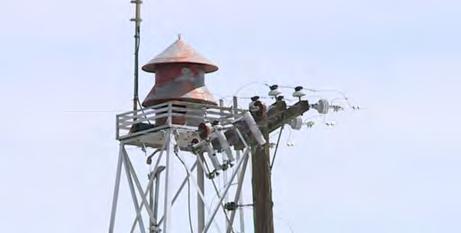


I think about the possibility of more mountain bikers, skiers, climbers, surfers and other outdoor minded folx coming together like our bike crew to act in solidarity for justice, and using their leverage for the greater good.


Having worked as an ally and coconspirator with different Native tribes over the past two decades, the Minden siren situation might seem unique, but it’s not. Tribal people defend their cultures, traditions, and ancestral lands because of the history of genocide and forced relocation of the US every day. Stopping the siren is an opportunity to remove hatred and historic discrimination towards tribal people. Can the town of Minden not find another way to honor and respect their first responders and firefighters with a messaging system that does not also provide a daily reminder to other area residents that they were once excluded from the community? Many local people say they never knew about the racist history of the siren and feel attacked by the racism call out.
This is not an individual issue but rather a systemic one. Now that the history has been shared alongside continuous asks from the Washoe community to stop the siren since 2006, will the town come together to stop it? This is a great opportunity for a truly respectful outcome, one in the direction of greater community health and mutual respect.
The pedaling is still relentless, but after a few hours the steepness of the climb backs off, and I start to see spacing in the canopy of the forest. A few moments later our group is collectively looking out over Da-owa-ga, known today as Lake Tahoe. We’re in collective awe. This was the home of the Washoe tribe for at least six thousand years before Minden first rang their sundown siren. The jewel of the Sierra is glistening in its many diverse hues of blue, and our group has completed the first piece of a long ride that loosely traced
a path the Washoe once traveled, from desert to lake, to gather food, medicinals, and spend the summer months on the shore of their beloved seasonal home.
I think about the words offered earlier in the day by retired teacher and Washoe descendant Marty Meeden about the racist history of the siren. I recall the songs, stories, and dances shared by other local Washoe and Paiutes that morning, and the true intention of our group gathering on May 29th. I think about the recent movement by the outdoor recreation community to go beyond environmental activism and see there is no protecting the Earth without protecting the people of the Earth, especially those from disenfranchised communities.
I think about the possibility of more mountain bikers, skiers, climbers, surfers and other outdoor minded folx coming together like our bike crew to act in solidarity for justice, and using their leverage for the greater good, such as organizing our ride through protest while fundraising $2k+ dollars to benefit Washoe outdoor education.


Stop the Siren. It starts with acknowledging it, centering the voice and position of those who haven’t had a choice, and looking forward in a way that is not love for some, but love for all. That is inclusion. That is respect. That is a community looking forward, not backward.
31 - Aug 1 — Mendo Hopper2 / Mendocino County / Two day adventure ride / GrasshopperAdventureSeries.com

September
11 — Gold Country Century Challenge Road & Gravel Ride / Nevada City / RotaryGoldCountryChallenge.com
Stetinas Pay Dirt
— Sept 11, 2021 — Stetinas Pay Dirt / Carson City / Expedition of a lifetime / Gravel event in Pine Nut Mountains / StetinasPayDirt.com


Race the Rails
— Sept 11, 2021 — Race the Rails / Ely, Nevada / Mountain bikers and road bikers race against the train / ElyNevada.net/racethe-rails

Tour de Tahoe
— Sept 12, 2021 — Tour de Tahoe – Bike Big Blue / Lake Tahoe / Ride around Lake Tahoe’s beautiful 72-mile shoreline / BikeTheWest.com


12 — Grizzly Peak Century / Moraga / Three routes / Grizz.org/century
at your our own pace / Use code ADVENTURE for $25 off / Events.Arthritis.org




17-19 — Silver State 508 / Reno, NV / “The toughest 48 hours” in Sport / the508.net
OATBRAN
— Sept 26 - Oct 2, 2021 —
OATBRAN (One Awesome Tour Bike Ride Across Nevada / Lake Tahoe to Baker, NV / Epic cycling journey across Nevada / BikeTheWest.com
Cycle across America’s Loneliest Road, Hwy 50
SEPTEMBER
September
25 — Gold Rush MTB / Folsom / TotalBodyFitness.com
25 — Grizzly 100 & Big Bear MTB Gran Fondo / Big Bear Lake / bbvrace.com

26 — Mare Island Pedal Fest / Vallejo / Naval shipyard / RideNapaValley.com
Ashland Mountain Challenge — Oct 2 - 3, 2021 — Ashland Mountain Challenge / Ashland / Racing on east side of Mt Ashland / 4 stages / Mandatory climb to top / CaliforniaEnduro Series.com


Sea Otter Classic — Oct 7 - 10, 2021 — Sea Otter Classic / Monterey / World premier cycling festival / Races, events, vendors, camping and more / SeaOtterClassic.com


17 — NAPA9 / Napa Valley / 125 mile adventure / RideNapaValley.com
Filthy 50+ — Oct 30, 2021 — Filthy 50+ / San Diego / 50+ & 30 Mile Rides / Kids Ride / Fast and flowy for all skill levels / Awards for top finishers / QuickNDirtyMTB.com

E-Dirty Cross

— Nov 13, 2021 — E-Dirty Cross / San Diego / Class 1 e-bikes only / Singletrack, fireroads, jumps, rock features and more / standard bike kids race / QuickNDirtyMTB.com



Dirty 30 — Dec 5, 2021 —









Dirty 30 / San Diego / 30 & 12 miles / 100% hand-built trails / fun and flowy terrain / Occasional rock features / QuickNDirtyMTB.com

Mammoth Sumer Jam
— All Summer Long —
Mammoth Summer Jam Concert Series
/ Mammoth / Fun for the whole family / 15 nights of live music / Season passes available / MammothSummerJam.com

September
Adventure Van Expo
— Sept 18 - 19, 2021 —
Adventure Van Expo
/ Lake Tahoe / Free entry / Van builds, campers, and open house vans / Food, gear, tunes and camping / AdventureVanExpo.com

Yosemite Facelift

— Sept 21 - 26, 2021 —
Yosemite Facelift / Yosemite / Volunteer clean up event / Limited programs due to COVID / Option to join remotely via hybrid virtual event / YosemiteFaceLift.com
October
Adventure Van Expo
— Oct 16 - 18, 2021 —
Adventure Van Expo / Big Bear Lake / Free entry / Van builds, campers, and open house vans / Food, gear, tunes and camping / AdventureVanExpo.com
July
24 — Tahoe Paddle Jam / Lake Tahoe / TahoePaddleRacing.com
Ta-Hoe Nalu Paddle Fest

— Aug 7 - 8, 2021 — Ta-Hoe Nalu Paddle Fest / Kings Beach, Lake Tahoe / World’s original paddle festival / Racing, paddling, food, family, and fun / TahoeNalu.com
28 — Tahoe Downwinder / Lake Tahoe / TahoePaddleRacing.com
September
19 — Tahoe Cup Lake Crossing / Lake Tahoe / TahoePaddleRacing.com
July
4 — Santa Cruz Sunrise Rotary Club’s Firecracker Run / Santa Cruz / santacruzfirecracker10k.org
18 — Blood, Sweat & Beers / Auburn / BloodSweatBeers.com
18 - 19 — San Francisco Marathon / SF / TheSFMarathon.com
19 - 21 — Badwater 135 / Furnace Creek Lone Pine / “The World’s Toughest Road Race” / BadWater.com

31— Truckee Half Marathon / Truckee / TruckeeMarathon.com
August


14 — Remembrance Run / Carson City to Yerington / In honor of survivors of Native American boarding schools / Facebook. com/events/387717469200940/
15 — Good Dog - Dirty Dog 5K/10K / Folsom SRA / TotalBodyFitness.com
22 — Fair Oaks Sun Run / Fair Oaks / FairOaksSunRun.com
28 — Graniterock River Run / Hollister / runsignup.com/Race/CA/Hollister/Granite rockRiverRun
28 — Race for the Arts / Sacramento / RaceForTheArts.com
28 — Angel Island Half Marathon & 10K / Angel Island State Park / Envirosports. com
September
12 — Buffalo Stampede / Sacramento / BuffaloStampedeRun.com
12 — Giant Race / San Francisco / Half Marathon, 10K, 5K / race-sfgiants.com
18 — She.Is.Beautiful / Santa Barbara / RunSheIsBeautiful.com






September
18 — Lederhosen 5K / Olympic Valley / TahoeTrailRunning.com
25 — Gold Rush Trail Run / Granite Beach / TotalBodyFitness.com
26 — Oakdale Chocolate Festival Run / Oakdale / OnYourMarkEvents.com
2 - 3 — Urban Cow Half Marathon, 5K Run/ Walk / Sacramento / UrbanCowHalf.com
9 — Ruth Anderson Memorial Endurance Run / Lake Merced, San Francisco / UltraSignUp.com
17 — Graniterock Rock & Run 5K and 10K / Aromas / runsignup.com/Race/CA/ Aromas/RockandRun

17 — Folsom Blues Breakout 13.1 / Folsom / Plus 5K, Relay, & Kids’ 1K / FolsomBluesHalf.org
November
6 — Rio Del Lago 100 Mile Endurance Run / Folsom / NorCalUltras.com
7 - 8 — Badwater Salton Sea / AnzaBorrego State Park / 81 miles / 45 teams of two or three ultrarunners / BadWater.com

13 — Feat to the Beach 200 Mile Relay / Fresno to Pismo Beach / 4 - 12 person teams / SierraCascades.com
14 — T9 Mermaid Run San Francisco / Golden Gate Bridge / 5K, 10K, Sirena 10mi / MermaidSeries.com
TBD — Santa Run Silicon Valley / San Jose / SantaRunSV.com
July
24 — Open Water Swim Clinics / Santa Cruz / runsignup.com/Race/CA/SantaCruz/ OWSClinics
25 — Alpine Fresh Water Swim / Truckee / TahoeSwimming.com
August
1 — Golden Gate Bridge Swim / San Francisco / WaterWorldSwim.com
8 — Lake Tahoe Sharkfest Swim / Incline Village, NV / SharkFestSwim.com

29 — Lake Tahoe Open Water Swim / Tahoma / TahoeSwimming.com
September
11 — Golden Gate Sharkfest Swim / Sausalito / SharkFestSwim.com
25 — Alcatraz Sharkfest Swim / San Francisco / 1.5mi from Alcatraz to Aquatic Park / SharkFestSwim.com
3 — San Francisco Bay Open Water Swim / San Francisco / Point-to-point 1.5 mile swim & .5 mile swim/ SwimAcrossAmerica. org/sanfrancisco
10 — San Diego Sharkfest Swim / San Diego Harbor / SharkFestSwim.com
11 — Dip and Dash Swim-Run & Team Challenge / Santa Cruz / FinishLineProduction.com
24 - 25 — Donner Lake Triathlon / Truckee / Half Tri, 70.3, Olympic Tri, Sprint Tri, Kids’ Tri, Aquabike / DonnerLakeTri.com

7 — Annual Granite Bay Triathlon / Granite Beach, Folsom SRA / TotalBodyFitness. com
7 — Pasadena Triathlon, Duathlon, & Angel 5K / PasadenaTriathlon.com
8 — Tri Santa Cruz / Santa Cruz / FinishLineProduction.com
21 — XTERRA Lake Tahoe / Incline Village, NV / BigBlueAdventure.com
28 - 29 — Lake Tahoe Triathlon / Tahoma / LakeTahoeTri.com
12 — Ironman 70.3 Santa Cruz / Santa Cruz / Ironman.com
19 — Shaver Lake Triathlon / Shaver Lake / Sprint & Olympic, Relays, 5K & 10K Runs / SierraCascades.com
25 — Pacific Coast Triathlon/Duathlon / Crystal Cove State Beach / OCTriSeries. com
26 — Santa Cruz Triathlon / Santa Cruz / SantaCruzTriathlon.org
2 — T9 Mermaid Triathlon & Duathlon / Capitola / International Tri, Sprint Tri, Sprint Du / MermaidSeries.com
10 — Orange County Triathlon/Duathlon / Lake Mission Viejo / OCTriSeries.com
24 — Herbalife24 Triathlon / Los Angeles / Herbalife24tri.la
List yor events for FREE on our online calendar at asjmag.com/add-event

List your event for FREE on our website. Advertise in our next issue Reach out to events@ adventuresports



The Zenbivy MotoBed™ is the best thing to happen to camping since, well, the first time a human ever slept on the ground. We were already madly in love with the Zenbivy Light Bed sleep system for backpacking; to luxuriate in the same cloud of comfort with zero setup hassle is sheer bliss.
The MotoBed™ includes a dual-layer mattress, convertible rectangular top quilt, Pongee sheet with integrated hood, and Pongee pillowcase for your favorite pillow, and it all stores in a convenient carry/storage bag.
Set up is ridiculously simple. Just unclip the storage bag, roll out the bed, give the self-inflating 3-inch thick mattress a little time to inflate, then top it off to your firmness preference. Climb on in and ahhhhh, sweet dreams.
The convertible comforter looks like a rectangular sleeping bag, but zips into a semi-rectangular quilt that drapes around you like the blankets on your own bed, allowing for movement yet keeping you nice and warm. A hood built in to the sheet accommodates your favorite standard-size pillow from home and insulates your head and arms on colder nights.
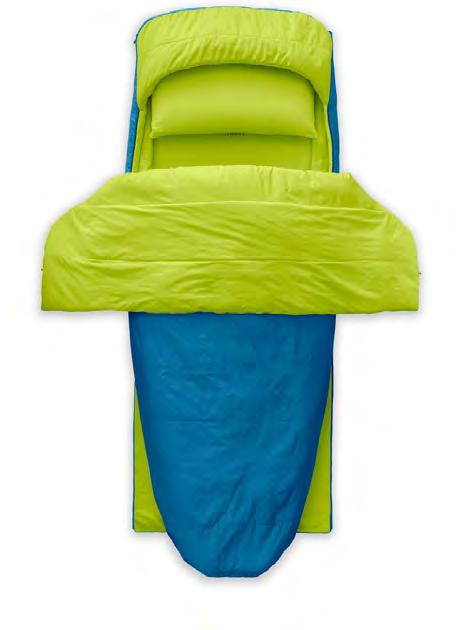
When it’s time to pack up, all you gotta do is pull the plug, roll ‘er up, and stash it in the included storage bag. La voilà! Your sleep system is ready for the next adventure before you’ve even finished your current one!
Select from three different color ways. Sizes L and XL. Synthetic fill, 35 degree (45 comfort).
MSRP: $299.00-$319.00 • zenbivy.com
2
GOOD TO-GO FOOD KITS
Good To-Go’s mission is to “change how people eat on-thego.” The company’s dehydrated meals (just add boiling water) are both healthy and quick-to-make, and we’ve been enjoying its delicious, nutritious offerings on backpacking, bike packing, paddling and backcountry skiing adventures for several years now.
So, we were delighted to learn of the all-new Food Kits that come in a range of sizes to fit any diet and budget. Choose from several different types of kits; order multiple kits for extended trips, larger groups, or to keep a solid stash of food on hand for emergency preparedness.

All Good To-Go meals are made with no preservatives, and are gluten-free plus are low in sodium. We’re especially fond of the vegan and vegetarian options: “Good To-Go” for our health, the welfare of our fellow earthlings, and our planet!
MSRP: $73.00-$262.00 • goodto-go.com
KANE REVIVE ACTIVE RECOVERY SHOE
First off, this recovery shoe is made of sugarcane. Yep, you read that right … Kane footwear uses BounceBack™ foam based on sugarcane, and the Revive is the first one-piece injection molded shoe made from eco-sustainable materials.

That certainly caught our attention, but it got even better when we slipped Revive on after a long trail run and felt it work its magic.
See, Revive is designed to help stimulate muscle recovery while combatting fatigue. This shoe boasts superior cushioning along with precise
biomechanics; Kane’s proprietary blend of EVA, a 10mm heel raise, and arch support ensure an easy transfer from heel to toe, allowing foot and leg muscles to recover.
Kane donates 1% of its gross sales to environmental non-profits through 1% For the Planet.
Comes in a variety of colors; unisex sizing.
MSRP: $70.00 • kanefootwear.com
Let the adventure begin with Gregory’s latest women’s backpack, the Kalmia 60. We love that this pack is constructed with recycled-content fabrics, and its durable water repellent coating is PFC-free. Any product that’s designed to reduce its environmental footprint captures our interest!

You’ll notice the comfort of the Kalmia 60’s dynamic fit from the get-go … and more importantly, through all the miles along the trail. The pack features revolutionary FreeFloat 360 suspension, technology that allows for extraordinary flexion and rotation, moving with your body.
Kalmia 60 also offers organizational options galore, and a list of other unique features too long to include in this review, so be sure to check out the Gregory website for all the sweet deets.
Comes in Equinox Grey or Bordeaux Red in sizes XS/SM, SM/MD, XS/SM Plus, and SM/MD Plus (yes, it’s the first pack to be designed in plus sizes!).
Men’s version (Katmai) also available in regular and plus sizes.
MSRP: $279.95
• gregorypacks.com
The Five Ten NIAD (an acronym for Nose In A Day) is a classic climbing shoe that pretty much does it all. From the indoor gym to the great outdoors, face to crack, granite to sandstone, this shoe will take excellent care of you wherever and whatever you climb.

The NIAD boasts Stealth® C4™ rubber edges, which offer unparalleled versatility. Grip, smear, edge, match, and push your limits with confidence.
A form fit heel, stiff midsole, and lined uppers offer excellent feel and remarkable comfort. Lace closures allow for the snug fit that gives your feet the ability to mold to just about any climbing surface. Extended toe rubber offers increased toe friction.
Women’s version is also available.
MSRP: $150.00 • adidas.com

The Crag Leash™ is the leash for your canine adventure companion. Easily adjustable, you can extend it to its full 6 feet, yet quickly shorten it to 3.5 feet when you need to keep your furry friend closer.
A padded handle, convenient accessory loop for pick-up bags or small clip-on items, and strong Tubelok™ webbing that holds its color are some of Ruffwear’s signature leash features. For those lowlight conditions, integrated reflectivity helps boost visibility.
The Crag Leash™ can be waist-worn or hand-held, and easily secures around a post or tree. It comes in a wide array of designs and colors; pair with a matching Crag Collar™ to complete your pup’s kit.
MSRP: $34.95 • ruffwear.com



